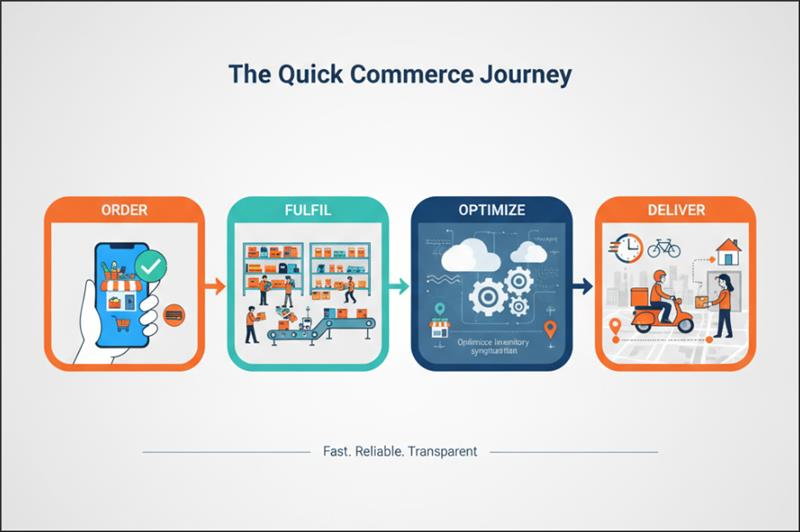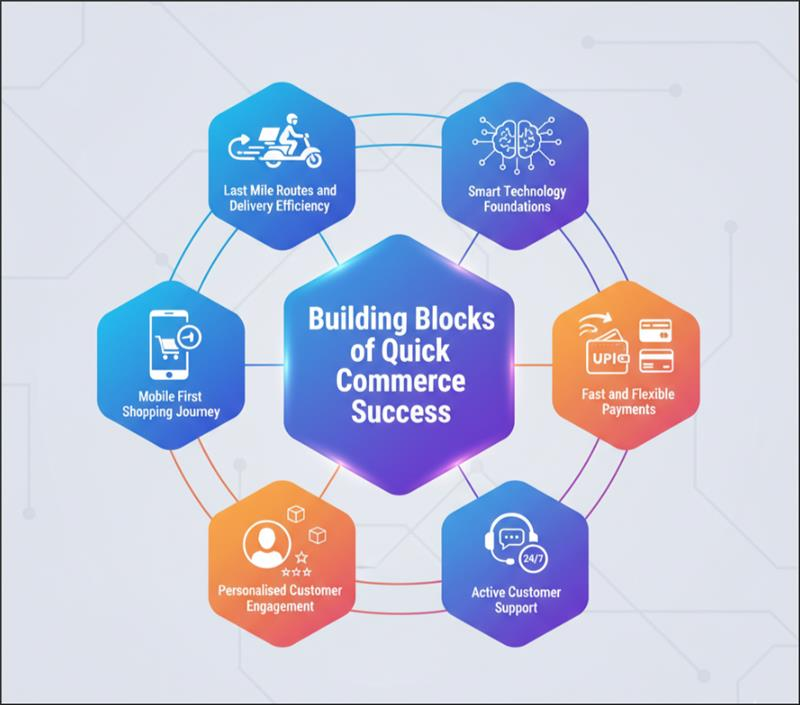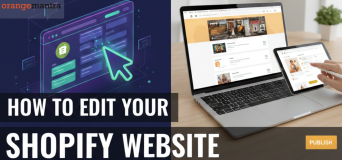
Q-commerce or quick commerce is a rapidly developing e-commerce model that brings essentials such as snacks, medicines, and groceries within 10-30 minutes. It is driven by AI, hyperlocal logistics, and dark stores and is aimed at convenience for urgent consumer needs. This $198B market is transforming retail with the right combination of technology, real-time information and on demand consumer actions and behaviour.
Here’s what you will learn:
Did you ever need to have snacks at midnight or run out of the necessary ones just before an important meeting and have them delivered to your door in a couple of minutes? That is the magic of quick commerce, the modern revolution that is transforming how we shop, consume, and expect convenience.
Once seen as a futuristic vision, but now it is a reality that people can purchase everyday essentials and have them delivered faster than it takes to make a cup of coffee. Behind this pace is an exceptional combination of technology, hyperlocal logistics, and data-driven intelligence.
Table of Contents
Still wondering how quick commerce works?
For those curious about quick commerce development services, we have prepared a detailed guide. Let us uncover what quick commerce is, how it works behind the scenes, and why it’s becoming the next big wave in the retail industry. From its economic impact to a complete blueprint on building your own Q-commerce app, here’s everything you need to know about the 10-minute economy transforming global retail.
Key Insights
- Quick commerce is redefining retail with 10–30-minute deliveries powered by tech and local hubs.
- A deep knowledge of how quick commerce works and upcoming opportunities in the future.
- Quick commerce is not only driving benefits for business giants but consumers, delivery partners, and the economy as well.
- 675 million people globally used quick commerce services in 2025, with usage expected to reach 900 million by 2029.
- The global market is set to hit US$198B in 2025, growing to US$286B by 2030.
- Building a reliable app demands speed-focused UX and advanced backend systems.
What is Quick Commerce?
As stated by its name, quick + commerce refers to every online retail commercial model delivering products quickly. Unlike traditional e-commerce models, which may promise you next-day or same-day delivery, quick commerce or q commerce pushes for an ultra-fast delivery of typically 10-30 minutes from ordering to doorstep delivery.
- Speed – the options and logistics to deliver as fast as possible.
- Convenience – a mobile-first, frictionless ordering experience.
- Proximity – placing inventory close enough to the customer (micro-warehouses or “dark stores”) so the delivery radius is small and travel time is minimal.
Primarily seen as a niche, quick commerce companies have now scaled to a revolutionary market shift with huge profits.
To illustrate its scale, according to Statista, in 2025, the quick commerce market was estimated to have around 195 billion U.S. dollars in global revenues, increasing from the previous year’s estimated 171 billion dollars. By 2030, revenues in the quick commerce market are forecast to exceed 283 billion U.S. dollars worldwide.
How Does Quick Commerce Work?
With such impressive numbers fueling the quick commerce boom, you might be wondering how quick commerce works. What actually happens behind the scenes that makes a 10-minute delivery possible? Let us have a detailed view of the process of the quick commerce working model.
Step 1: Order Placement
A user launches the mobile app, sees what’s in stock in their local delivery radius, selects items, and checks out with a couple of taps according to their requirements. The UI is designed for speed: fewer screens, immediate payment, and livestock info.
Step 2: Smart Fulfillment
Orders are then routed to the nearest micro fulfillment center or dark store that is in the same neighborhood or a few kilometers away from the customer. These hubs have a curated section of all high-demand products that people order the most, so that they can be picked, packed, and delivered quickly.
Step 3: Technology Behind the Scenes
Here’s where the “engineering” happens, though we’ll keep it accessible:
- Inventory systems update in real time, so you only see available stock.
- Route optimization assigns a delivery partner to the most efficient path, accounting for current traffic, start point, and delivery sequence.
- Dashboards monitor the flow of the orders picked, packed, dispatched, and delivered.
Step 4: The Delivery
A delivery partner (on bike, scooter, or bicycle) picks up the package and enters a delivery radius of perhaps 2–5 km. It’s dropped at the customer’s door, tracked, time-noted, often with minimal interface. The closure of the loop is fast, reliable, and transparent.
By designing each of these steps for minimal delay, the top quick commerce companies in India deliver their promise of speed. The infrastructure, app experience, logistics network, and delivery partner ecosystem all must align.
The Real Value of Quick Commerce
Let’s explore why Q-commerce isn’t just a faster way to shop—it impacts four key stakeholder groups. Understanding each helps you appreciate both the opportunity and the operational complexity.
1) For Business Houses
For retailers, brands, and service providers, quick commerce platforms in India open new fronts:
- Higher purchase frequency: When goods arrive fast, consumers order more, maybe smaller baskets, but repeatedly.
- Stronger loyalty: Instant fulfilment helps build “go-to” status among users.
- Data-driven insights: Since orders come in fast, you get rapid feedback loops on product choice, location demand, delivery latency, and more.
2) For Consumers
From the user’s vantage point:
- Speed & convenience: The core benefit? Need something now, it arrives!
- Better service in emergencies: Whether medicine at midnight or forgotten party essentials, Q-commerce meets that.
- Seamless mobile experience: The ordering journey is fast, tracked, and transparent. A coherent experience increases satisfaction, and with that, repeat usage.
3) For Related Delivery Partners & Staff
This is often overlooked. Q-commerce creates:
- Career opportunity: Riders, fulfillment-center employees, packers, and warehouse technical support.
- Technological Advancements: Delivery apps have taken over all processes – including intelligent shipping routes and tracking packages, as well as transparent income and performance boards.
- Flexibility and independence: A good number of partners are getting to work in gig style or part-time that fits their schedules, and therefore multiple sources of income are easy to balance.
4) For the Economy of the Country
On the macro level, quick commerce helps to take the economy forward:
- Employment and micro-logistics growth: More warehousing, more riders, more tech infrastructure.
- Boosted consumption patterns: Easier access accelerates purchase behavior, increasing retail circulation.
- Innovation in logistics and fulfilment: The chain from supplier to doorstep becomes leaner, more tech-enabled.
When all four groups, i.e, business, consumer, staff, and economy benefit, the model becomes much more important and profitable. Ready to be part of this transformation? Let’s make your quick commerce journey today by building your own m-commerce app, the foundation of every successful Q-commerce business.
Core Elements That Drive Successful Quick Commerce Development
Do you know, recent data from Statista shows over 675 million people globally used quick commerce services in 2025, with usage expected to reach 900 million by 2029? But what makes these business models successful?
Quick commerce platforms in India are not merely doing business at a fast pace but doing it intelligently. All these 10-minute deliveries have behind them a system that is a mix of technology, operation, and customer knowledge. Now that you are aware of how quick commerce works, the next step is to understand the core elements supporting its work.
Mentioned are some core elements that drive this model successfully.
1) Last Mile Routes and Delivery Efficiency: Q-commerce is all about the management of the last mile. AI-based route optimization is now being used by companies to track traffic and predict delays, and assign the most efficient delivery paths to riders. It not only saves minutes but also money. Optimal logistics implies a reduction in fuel expenses, quicker turnarounds, and happy customers at their doors.
2) Smart Technology Foundations: Top quick commerce companies in India thrive on data. AI, machine learning, and IoT systems are the invisible engines running behind every instant order. Technology can be used to predict what customers will require next week, monitor live inventory changes, and prevent stockouts.
3) Mobile First Shopping Journey: For customers, everything starts on a screen. Smooth mobile apps are where quick commerce is made or lost. The best quick commerce app provides smooth surfing, one-touch checkout, and order tracking- so the user does not feel like waiting or guessing. Trust is achieved by a clean and intuitive app design, and when users trust you, they become customers.
4) Fast and Flexible Payments: The Quick commerce business model should not be held up because of checkout. Starting with credit and debit cards and moving on to digital wallets and UPI, the modern Q-commerce platforms are based on the principles of providing instant, secure, and versatile ways of payment.
5) Personalised Customer Engagement: The Secret of every best quick commerce app is personalization. AI-based insights are now used on platforms to suggest products based on purchasing and viewing preferences. Such as adding loyalty points, personalized offers, and timely alerts. This human element about technology is what makes the user come back frequently.
6) Active Customer Support: The support should also be able to move faster with features like 24/7 chatbots, live chat, or call support to make sure the customers do not feel stuck. And with instant feedback loops, businesses will be able to respond to what customers are saying before frustration is converted into churn. Since in a 10-minute economy, trust is the rate of reply.
Building Your Own Q-Commerce App Development? Stick To This Blueprint!
Feeling boosted to start your own quick commerce app? But confused about where to start? Building the best quick commerce app is not just about development and design but also about building an entire ecosystem. Here is a step-by-step process to build your own quick commerce app in a structured manner.
1) Market Research and Planning: This is where you establish your users, what they require, and why your solution will be superior.
- Check the India quick commerce competition 2025 of leading companies such as Blinkit, Zepto, GoPuff, and Instamart.
- Understand how quick commerce works for your target audience and location,
- Understand what the competitors are doing well and what their gaps are.
- The next step involves mapping of geography, the behavior of users, and the frequency of purchases.
- Secure your business model – will it be hyperlocal, warehouse-based, or aggregator-driven?
This is the stage that you build on, and the more you plan, the more you get to scale.
2) Designing Action: Design is where your users fall in love – or walk away in seconds.
- The Q-commerce interface must be blazing, clean, and user-friendly.
- Wireframes made by designers must reflect an actual shopping experience in real-time – ease in product browsing, one-tap check-out, and in-delivery tracking.
- Usage prototypes must undergo usability testing so that all the taps made are painless.
“Speed Meets Simplicity”, that’s the design mantra for quick commerce platforms in India. Now if you deeply understand how quick commerce works and your design is done, only then move to the next step. If not, stop reading and re-read this point again.
3) Development and Core Integration: Now that your design is ready it’s time to bring it to life. Now comes the real build.
- The front-end developers design mobile-first responsive interfaces, and the backend engineers establish the infrastructure, which is robust and scalable.
- Add APIs to payments, maps, route optimization, and live notifications to make sure that there is a smooth coordination between consumers, merchants, and delivery partners.
Hundreds of orders simultaneously should be processed by your app – fast and smooth.
4) Testing and Optimization: A Q-commerce application should be impeccable, since even a 10-second lag is costly to a client.
Mobile app testing team performs high quality performance checking, data security, GPS tracking, and stability of the apps in a variety of devices and networks.
It is also at this stage that stress tests are performed to determine that your app can withstand real-world surges such as the festive or weekend surges.
5) Launch and Market Rollout: Once tested, it’s now the showtime.
- Launch your app to the Play Store and App Store, keep a close watch on initial measurements and be prepared to do quick iterations.
- Test within a limited geographic area, analyze the usage patterns, collect feedback, and perfect the concept, and then expand.
- Monitor conversion rates, average delivery time, and user retention on the first day – data is your guide.
6) Continuous Growth and Maintenance: If you think your role ends at the market rollout, you may be wrong.
- Continue adding capabilities and quickly resolve bugs and optimize new versions of the OS.
- Introduce AI-powered suggestions, quicker payments, and new features according to the usage of insights.
- Your servers can be scaled as the number of users expands, and additional fulfillment areas can be added to sustain performance.
What Is the Cost of Quick Commerce App Development?
The cost of quick commerce app development depends on various factors such as business size, type of app and location you are catering to. Still, to make things clear for you here is an estimated stat with their approx. development time.
| Type of App | Description | Estimated Cost Range (USD) | Development Time (Approx) |
|---|---|---|---|
| Basic MVP App | Core features like product listing, cart, payment, and delivery tracking | $40,000 – $80,000 | 3–6 months |
| Mid-Level App | Includes real-time tracking, personalized recommendations, and an admin dashboard | $90,000 – $200,000 | 5–8 months |
| Advanced/Enterprise App | Full-scale Q-commerce platform with AI, route optimization, multi-warehouse integration, and loyalty systems | $200,000 – $400,000+ | 8–12 months |
The Future of Quick Commerce – Where is the Industry Heading?
Quick Commerce is not a retail phenomenon but is becoming the new trend of convenience in urban life, also leaving us with a question of what the future of quick commerce is?
- As consumers increasingly demand the delivery of necessities to their door in less than 15minutes, brands are reworking their logistics and technology infrastructure, as well as business models, to serve the instant gratification economy.
- Over the coming years, AI and predictive analytics will move the operations of Q-commerce to a higher plane – including better location of inventory and automated delivery using micro-warehouses and dark stores.
- Firms may turn to the use of data-driven predictions in order to minimize delivery periods and enhance cost-effectiveness. In the meantime, last-mile delivery will reach a new level with the help of drones, autonomous delivery vehicles, and IoT-related tracking systems.
However, the true future of quick commerce is personalization. This is the moment when entrepreneurs and startups should invest in scalable technology and sustainable logistics. The current innovators will not only be able to keep up, but they will establish the next generation of instant retail.
Conclusion
The concept of quick commerce has ceased to be a convenience but a lifestyle change, redefining the way we shop, work, and consume. It has turned the concept of instant into a luxury that is expected. It began as a promise of delivering in 10 minutes, but since then, it has become a technological trend, a movement in logistics innovation, as well as the increasing demand for immediacy worldwide.
Rapid commerce is going to maintain the meshing of the boundaries between online and offline shopping as businesses adopt automation, AI, and hyperlocal networks. To entrepreneurs and developers, this is the ideal time to create scalable, intelligent, and customer-first platforms that can succeed in the 10-minute economy.
Finally, the future of quick commerce will go to those who are able to understand how quick commerce works to reconcile speed, reliability, data, and personalization, and even technology and human convenience. It doesn’t matter whether it is a startup having to venture into the market or an already existing retailer planning to grow it; one thing is guaranteed: the faster you adapt, the better you stand in this changing retail revolution.
Frequently Asked Questions
1) What is quick commerce, and how does it differ from traditional e-commerce?
Quick commerce (Q-commerce) is a fast online retail option with delivery of products in 10-30 minutes. In contrast to conventional e-commerce, which takes hours or days, Q-commerce is based on hyperlocal dark stores, AI logistics, and real-time inventory to make deliveries instantly.
2) How does quick commerce work in India?
Quick commerce operates in four main processes, including placing orders, smart fulfillment that takes place in the local micro-warehouses, the real-time optimization of routes, and super-fast delivery over a mile. AI, GPS tracking, and live inventory management systems make each process possible.
3) What is the cost of quick commerce app development?
The development of quick commerce apps will cost depending on their scale:
- MVP App: $40,000-$80,000 (3-6 months)
- Mid-Level App: $90,000-$200,000 (5-8 months)
- Advanced / Enterprise application: $ 200,000-400,000 and above (8-12 months)
The cost depends upon various factors such as your target audience and location, and the scale of the business.
4) Which technologies are behind quick commerce platforms?
Quick commerce platforms in India are based on a technology stack, comprising AI, machine learning, IoT sensors, cloud computing, and mobile-first design. These will facilitate predictive analytics, real-time visibility of inventory, and real-time route optimization.






